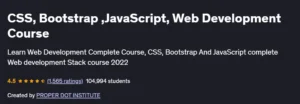What will you learn in Mastering Jest: A Complete Guide to Testing Course
- Gain hands-on experience writing clean, meaningful tests with Jest’s intuitive API for JavaScript and TypeScript applications
- Master Jest’s core matchers, snapshot testing, and custom matcher creation to ensure UI and logic consistency
- Test asynchronous code—callbacks, Promises, and async/await—with confidence and accuracy
- Mock functions, timers, classes, and external libraries (Axios, date utilities, SDKs) to isolate units and simulate dependencies
- Integrate Jest into CI/CD pipelines with coverage reporting, GitHub Actions, and CircleCI for a robust, automated testing workflow
Program Overview
Module 1: Introduction
⏳ 15 minutes (2 Lessons)
Topics: What is Jest; the three primary test types (unit, snapshot, integration)
Hands-on: Explore the “Test with Jest” example and quiz your understanding of Jest fundamentals
Module 2: Setting Up Jest
⏳ 30 minutes (4 Lessons + Quiz)
Topics: Configuring Jest for JavaScript and TypeScript; structuring test files; debugging tests
Hands-on: Install and configure Jest in a sample project; debug a failing test case
Module 3: Jest Matchers
⏳ 45 minutes (5 Lessons + Quiz)
Topics: Built-in matchers, error handling, Jest Extended, creating custom matchers
Hands-on: Write tests using common and extended matchers; build a custom matcher for your data types
Module 4: Writing Unit Tests
⏳ 45 minutes (5 Lessons + Quiz)
Topics: Structuring clean unit tests, global helpers, best practices
Hands-on: Refactor a legacy function into well-organized unit tests with clear assertions
Module 5: Snapshot Testing
⏳ 30 minutes (4 Lessons + Quiz)
Topics: Introduction to snapshots, creating and maintaining snapshots, avoiding common pitfalls
Hands-on: Add snapshot tests for React components or JSON outputs and update snapshots safely
Module 6: Testing Asynchronous Code
⏳ 45 minutes (5 Lessons + Quiz)
Topics: Callbacks, Promises, async/await patterns in tests
Hands-on: Write tests for an API-fetch function using callbacks, Promises, and async/await
Module 7: Mocking Core Functions & Timers
⏳ 60 minutes (6 Lessons)
Topics:
jest.fn(), timer mocks, class mocks, client/server mocking patternsHands-on: Mock timers and API calls to simulate timeouts and network responses
Module 8: Mocking External Libraries
⏳ 75 minutes (8 Lessons + Project)
Topics: Techniques for mocking Axios, date libraries, analytics SDKs, charting packages, and more
Hands-on: Complete the “Working with Jest Mocks” project, mocking multiple third-party packages
Module 9: Setup & Teardown
⏳ 30 minutes (4 Lessons + Quiz)
Topics: Test isolation, global setup/teardown, per-test hooks
Hands-on: Implement
beforeAll/afterAllhooks in a database integration test suite
Module 10: Test Coverage & CI/CD Pipelines
⏳ 30 minutes (4 Lessons + Quiz)
Topics: Generating coverage reports, enforcing coverage thresholds, integrating with GitHub Actions and CircleCI
Hands-on: Configure a GitHub Actions workflow to run Jest tests and upload coverage badges
Get certificate
Job Outlook
- The average salary for a QA/Test Engineer in the U.S. is $99,648 per year, reflecting strong demand for automated-testing expertise
- Jest skills are highly valued in JavaScript and full-stack roles across tech, finance, e-commerce, and media industries
- Proficiency in Jest testing opens opportunities as Frontend Developer, QA Automation Engineer, and DevOps Engineer with testing focus
- Integrating tests early in CI/CD pipelines aligns with modern DevOps and SRE practices, boosting team productivity and code quality
Specification: Mastering Jest: A Complete Guide to Testing Course
|
FAQs
- Strong familiarity with JavaScript basics is recommended.
- Understanding functions, arrays, objects, and ES6 syntax helps.
- Beginners in JS may struggle with testing concepts.
- Prior exposure to web development or Node.js is helpful but not mandatory.
- The course focuses on applying Jest in real-world testing scenarios.
- Improves employability as a Front-End, Full-Stack, or QA Engineer.
- Demonstrates expertise in writing unit, integration, and snapshot tests.
- Valuable for companies using React, Node.js, or other JS frameworks.
- Enhances portfolio with robust testing practices for professional projects.
- Freelance web development projects benefit from automated testing skills.
- Includes exercises on writing unit and integration tests for real projects.
- Covers test-driven development (TDD) workflows and best practices.
- Focuses on mocking, snapshot testing, and asynchronous code testing.
- Teaches debugging failing tests and improving code quality.
- Skills gained can be applied directly in professional web applications.
- Testing expertise is highly valued for software development roles.
- Demonstrates ability to write maintainable, bug-free code.
- Prepares developers for roles emphasizing quality assurance and TDD.
- Freelance or consultancy projects benefit from automated testing knowledge.
- Employers may offer higher salaries for developers proficient in testing frameworks.
- Some programming experience is mandatory; complete beginners may struggle.
- Focus is on applying testing concepts rather than learning from scratch.
- Step-by-step examples simplify writing tests and debugging code.
- Helps professionals understand software quality assurance principles.
- Guided projects make learning Jest practical and approachable for motivated learners.





